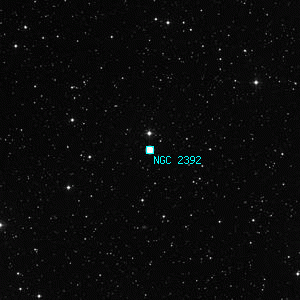NGC 2392

Overlaid DSS image of NGC 2392, 30' x 30' with north at top and west to the right
Aladin viewer for the region around NGC 2392
Eskimo Nebula, Clown Nebula
H IV 45, h 450, BD+21 1609, GC 1532, HD 59088, PK 197+17.1, PN G197.8+17.3, HIP 36369
H IV 45, h 450, BD+21 1609, GC 1532, HD 59088, PK 197+17.1, PN G197.8+17.3, HIP 36369
| Type | Planetary Nebula |
|---|---|
| Magnitude | 9.68 |
| Size | 0.78' x 0.7' |
| Right Ascension | 7h 29' 10.8" (2000) |
| Declination | 20° 54' 43" N |
| Constellation | Gemini |
| Classification | B, S, R, *9M, *8 nf 100" |
Observing Notes
Andrew Cooper
Feb 20, 2020 Waikoloa, HI (map)
20cm f/6 Newtonian, Cave Astrola @ 61x
Seeing: 7 Transparency: 6 Moon: 0%
Classic planetary, easily seen with the 8" and neighborhood light, brighter to the center with a disticnt halo, round, no color noted, 8th magnitude star 2' north
Andrew Cooper
Mar 1, 2011 Hale Pohaku, HI (map)
46cm f/4.5 Newtonian, Deep Violet @ 262x
Seeing: 6 Transparency: 6 Moon: 0%
A beautiful planetary, among the sky's best, a bright halo around an obvious central star, a distinctly blue color, the halo has a brighter inner disk, symmetrical, the outer shell ends abruptly about 20" from the central star
Andrew Cooper
May 6, 2005 Caballo Loco Ranch, Pima Co., AZ (map)
28cm f/10 SCT Nexstar 11
Beautiful! A great planetary! Inner core distinct from an outer halo, central star obvious, light blue color
Rev. T.W. Webb
May 19, 1885 Hardwick, Herefordshire, England (map)
H., observed this object as a 9 mg. star 'with a pretty bright nebulosity, equally dispersed all round; a very remarkable phenomenon.' h. describes it as an 8 mg. star 'exactly in the centre' (not exactly, E. of Rosse, D'A.) 'of an exactly round bright atmosphere, 25" in diam.' Sm., who rates it 7.5 mg., says he 'could only bring it to bear as a blurred star.' I was so much surprised at the result in my inferior telescope, that I cannot help supposing some temporary impediment to distinct vision at Bedford, for on coming accidentally across it in 1850 I found such a conspicuous nebulosity that I though it was either damp on the eye lens or a telescopic comet; and in 1852 I entered it as a 'bluish nebulosity, quite like a telescopic comet.' 1865, with 5-1/2in., I perceived a very faint trace of a brighter border s a little f. The E. of Rosse saw a marvellous object--a star surrounded by a circular nebula., in which, close to the star, is a little black spot. This nebula is encompassed, first by a dark then by a luminous ring, very bright, and always flickering; perhaps a spiral. Buffham sees the dark ring with 9-in. 'With.' Key's 18-in. mirror showed two concentric bright rings and the dark spot, '68. A mass of luminous gas. It lies 2° sf δ.― Celestial Objects for Common Telescopes, T. W. Webb, 1917
Captain William Henry Smyth
Mar 21, 1836 No. 6 The Crescent, Bedford, England (map)
150mm f/17.6 refractor by Tully 1827
A star enveloped in an atmosphere, with a distant companion on the loins of Pollux. A 7½, greyish white; B 8, dusky blue; other stars following. This was observed by ♅. in 1787, as a "star of the 9th-magnitude, with a pretty bright nebulosity, equally dispersed all around. A very remarkable phenomenon." H, whose No. 450 it is, describes it, "a star of the 8th magnitude, exactly in the centre of an exactly round bright hemisphere 25" in diameter." The beauty of this is, in great measure, lost to my instrument, for I could only bring it to bear as a burred star: it lies about 2° to the east-south-east of Wasat, δ Gemi- norum, whose alignment is already treated of.― A Cycle of Celestial Objects Vol II, The Bedford Catalogue, William Henry Smyth, 1844
Other Data Sources for NGC 2392
Nearby objects for NGC 2392
5 objects found within 60'
| 61 Geminorum | 63 Geminorum | HD 58246 |
| HD 58246A | HD 58246B |
Credits...
Drawings, descriptions, and CCD photos are copyright Andrew Cooper unless otherwise noted, no usage without permission.
A complete list of credits and sources can be found on the about page
NGC 2392